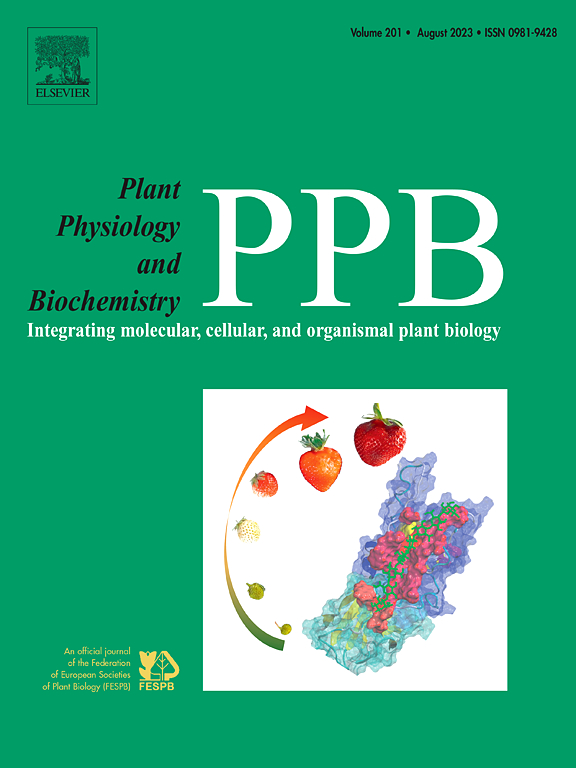综合生理、转录组学和代谢组学分析揭示了玉米耐镉性的杂种优势
IF 5.7
2区 生物学
Q1 PLANT SCIENCES
引用次数: 0
摘要
杂种优势是指杂种杂种在产量和抗逆性方面优于亲本,但其在玉米抗Cd方面的作用尚不清楚。本研究综合了镉胁迫下杂交种郑单958 (ZD958)及其亲本的生理、转录组学和代谢组学分析。与亲本相比,ZD958在Cd胁迫下表现出更优越的形态性状(如株高、根系生物量),过氧化氢酶(CAT)活性显著提高。关键性状的中亲本杂种优势(MPH)在2.73% ~ 25.90%之间,表明Cd处理下杂种具有较强的优势。转录组学分析鉴定出Cd胁迫下ZD958中904个独特的差异表达基因(deg),加权基因共表达网络分析(WGCNA)揭示了两个关键模块。代谢组学分析鉴定出902种代谢物,ZD958中差异积累的代谢物主要富集于苯基丙烷类生物合成、甘油磷脂代谢和糖基磷脂酰肌醇锚定生物合成。在非加性表达(NAE)基因分析中,ZD958在Cd胁迫下也特异性下调了一个基因。等位基因特异性表达(ASE)分析显示ZD958有12个遗传过显性基因。综合多组学分析表明,苯丙类生物合成和淀粉、蔗糖代谢在ZD958抗Cd胁迫的杂种优势中起关键作用。我们的发现为苯丙类生物合成和淀粉/蔗糖代谢如何介导Cd耐受性的杂种优势提供了新的见解。本文章由计算机程序翻译,如有差异,请以英文原文为准。
Integrated physiological, transcriptomic and metabolomic analysis revealed heterosis for cadmium tolerance in maize
Heterosis describes superior performance of F1 hybrids over parents in yield and stress tolerance, yet its role in Cd tolerance remains poorly characterized in maize. This study integrated physiological, transcriptomic, and metabolomic analyses for the hybrid Zhengdan958 (ZD958) and its parents under cadmium (Cd) stress. Compared to parental lines, ZD958 consistently exhibited superior morphological traits (e.g., plant height, root biomass) and significantly enhanced elevated catalase (CAT) activity under Cd stress. Mid-parent heterosis (MPH) for key traits ranged from 2.73 % to 25.90 %, confirming robust hybrid vigor under Cd exposure. Transcriptomic analysis identified 904 unique differentially expressed genes (DEGs) in ZD958 under Cd stress, with weighted gene co-expression network analysis (WGCNA) revealing two key modules. Metabolomic analysis identified 902 metabolites, and the differentially accumulated metabolites in ZD958 primarily enriched in phenylpropanoid biosynthesis, glycerophospholipid metabolism, and glycosylphosphatidylinositol-anchor biosynthesis. Analysis of non-additive expression (NAE) genes identified one gene under both conditions, which was also specifically down-regulated in ZD958 under Cd stress. Analysis of allele-specific expression (ASE) genes revealed 12 genetically over-dominant genes in ZD958. Integrated multi-omics analysis highlighted the critical roles of phenylpropanoid biosynthesis and starch and sucrose metabolism in the heterosis of ZD958 to Cd stress. Our findings provide novel insights into how phenylpropanoid biosynthesis and starch/sucrose metabolism mediate heterosis for Cd tolerance.
求助全文
通过发布文献求助,成功后即可免费获取论文全文。
去求助
来源期刊
CiteScore
11.10
自引率
3.10%
发文量
410
审稿时长
33 days
期刊介绍:
Plant Physiology and Biochemistry publishes original theoretical, experimental and technical contributions in the various fields of plant physiology (biochemistry, physiology, structure, genetics, plant-microbe interactions, etc.) at diverse levels of integration (molecular, subcellular, cellular, organ, whole plant, environmental). Opinions expressed in the journal are the sole responsibility of the authors and publication does not imply the editors'' agreement.
Manuscripts describing molecular-genetic and/or gene expression data that are not integrated with biochemical analysis and/or actual measurements of plant physiological processes are not suitable for PPB. Also "Omics" studies (transcriptomics, proteomics, metabolomics, etc.) reporting descriptive analysis without an element of functional validation assays, will not be considered. Similarly, applied agronomic or phytochemical studies that generate no new, fundamental insights in plant physiological and/or biochemical processes are not suitable for publication in PPB.
Plant Physiology and Biochemistry publishes several types of articles: Reviews, Papers and Short Papers. Articles for Reviews are either invited by the editor or proposed by the authors for the editor''s prior agreement. Reviews should not exceed 40 typewritten pages and Short Papers no more than approximately 8 typewritten pages. The fundamental character of Plant Physiology and Biochemistry remains that of a journal for original results.

 求助内容:
求助内容: 应助结果提醒方式:
应助结果提醒方式:


